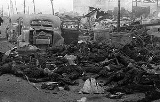
Bombing of Tokyo in World War II
Overview
United States Army Air Forces
The United States Army Air Forces was the military aviation arm of the United States of America during and immediately after World War II, and the direct predecessor of the United States Air Force....
during the Pacific campaigns
Pacific War
The Pacific War, also sometimes called the Asia-Pacific War refers broadly to the parts of World War II that took place in the Pacific Ocean, its islands, and in East Asia, then called the Far East...
of World War II
World War II
World War II, or the Second World War , was a global conflict lasting from 1939 to 1945, involving most of the world's nations—including all of the great powers—eventually forming two opposing military alliances: the Allies and the Axis...
. The U.S. mounted a small-scale raid on Tokyo in April 1942, with large morale effects. Strategic bombing
Strategic bombing
Strategic bombing is a military strategy used in a total war with the goal of defeating an enemy nation-state by destroying its economic ability and public will to wage war rather than destroying its land or naval forces...
and urban area bombing began in 1944 after the long-range B-29 Super Fortress bomber entered service, first employed from China and thereafter the Mariana Islands
Mariana Islands
The Mariana Islands are an arc-shaped archipelago made up by the summits of 15 volcanic mountains in the north-western Pacific Ocean between the 12th and 21st parallels north and along the 145th meridian east...
. B-29 raids from those islands commenced on November 17, 1944 and lasted until August 15, 1945, the day Japan capitulated.
Unanswered Questions
Discussions

